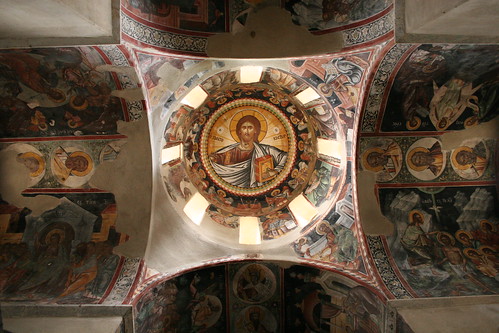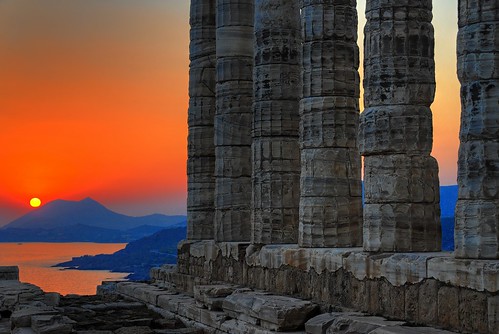Daphni Monastery
Located just outside of Athens, almost half-way along the ancient Sacred Way t o Eleusis, the Daphni (also Dafni) Monastery is an 11th-century Byzantine monastery. The monastery is founded on an ancient sacred site which in Antiquity had a sanctuary of Apollo. (The name Daphni, derived from daphnai (laurels) sacred to the god). The first monastery that succeeded the sanctuary was erected in the 6th century and was enclosed by strong defensive walls, almost square in plan. The second phase, dated around 1080 AD, is the one preserved. Now a museum and World Heritage Site, it is considered one of the great masterpieces of the Byzantine architecture. The monastery's classic Greek-cross-octagon design is a refinement of a plan first used at Osios Loukas, on the road to Delphi. Its mosaics are considered among the great masterpieces of the Middle Ages. More information: http://www.culture.gr/h/2/eh251.jsp?obj_id=1514
o Eleusis, the Daphni (also Dafni) Monastery is an 11th-century Byzantine monastery. The monastery is founded on an ancient sacred site which in Antiquity had a sanctuary of Apollo. (The name Daphni, derived from daphnai (laurels) sacred to the god). The first monastery that succeeded the sanctuary was erected in the 6th century and was enclosed by strong defensive walls, almost square in plan. The second phase, dated around 1080 AD, is the one preserved. Now a museum and World Heritage Site, it is considered one of the great masterpieces of the Byzantine architecture. The monastery's classic Greek-cross-octagon design is a refinement of a plan first used at Osios Loukas, on the road to Delphi. Its mosaics are considered among the great masterpieces of the Middle Ages. More information: http://www.culture.gr/h/2/eh251.jsp?obj_id=1514
 o Eleusis, the Daphni (also Dafni) Monastery is an 11th-century Byzantine monastery. The monastery is founded on an ancient sacred site which in Antiquity had a sanctuary of Apollo. (The name Daphni, derived from daphnai (laurels) sacred to the god). The first monastery that succeeded the sanctuary was erected in the 6th century and was enclosed by strong defensive walls, almost square in plan. The second phase, dated around 1080 AD, is the one preserved. Now a museum and World Heritage Site, it is considered one of the great masterpieces of the Byzantine architecture. The monastery's classic Greek-cross-octagon design is a refinement of a plan first used at Osios Loukas, on the road to Delphi. Its mosaics are considered among the great masterpieces of the Middle Ages. More information: http://www.culture.gr/h/2/eh251.jsp?obj_id=1514
o Eleusis, the Daphni (also Dafni) Monastery is an 11th-century Byzantine monastery. The monastery is founded on an ancient sacred site which in Antiquity had a sanctuary of Apollo. (The name Daphni, derived from daphnai (laurels) sacred to the god). The first monastery that succeeded the sanctuary was erected in the 6th century and was enclosed by strong defensive walls, almost square in plan. The second phase, dated around 1080 AD, is the one preserved. Now a museum and World Heritage Site, it is considered one of the great masterpieces of the Byzantine architecture. The monastery's classic Greek-cross-octagon design is a refinement of a plan first used at Osios Loukas, on the road to Delphi. Its mosaics are considered among the great masterpieces of the Middle Ages. More information: http://www.culture.gr/h/2/eh251.jsp?obj_id=1514How to get to Daphni: http://www.sacred-destinations.com/greece/daphni-monastery.htm
Monastery of Kaisariani
The Byzantine fortified Monastery of Kaisariani is nestled amongst cypress, pine cedar and almond trees in a peaceful location. From Kaisariani Monastery A fifeteen minute drive on A narrow 2 lanes road, lead nearly to the top of the mountain from where excellent views of the city of Athens below can be enjoyed. Pre-Chrisitan remains of Roman date are present but the main structure was built in the 11th century AD and dedicated to the Panagea or Virgin Mary. The four columns supporting the dome are from a pre-existing ancient temple that sto od on the site. The monastery is cruciform in shape.
od on the site. The monastery is cruciform in shape.
The Byzantine fortified Monastery of Kaisariani is nestled amongst cypress, pine cedar and almond trees in a peaceful location. From Kaisariani Monastery A fifeteen minute drive on A narrow 2 lanes road, lead nearly to the top of the mountain from where excellent views of the city of Athens below can be enjoyed. Pre-Chrisitan remains of Roman date are present but the main structure was built in the 11th century AD and dedicated to the Panagea or Virgin Mary. The four columns supporting the dome are from a pre-existing ancient temple that sto
 od on the site. The monastery is cruciform in shape.
od on the site. The monastery is cruciform in shape. Imp Info: Members of both sexes must be adequately dressed for their visit to the monasteries. Since this area is one of the last heavily forested areas around Athens, it is protected and closely supervised and entry is permitted between the 06:00 -19:00 hrs.
How to get to Kaisariani from Athens: Unfortunately no bus goes to the monastery. The closest you can get to is Kaisariani cemetery by bus 224, all but from there it will take you 15 minutes to reach the mountain base & another hour of hiking to reach the Monastery. Hence the best option would be to drive down unless you are an avid trekker. (Source: tripadvisor.com’s Greek destination expert).
The Temple Of Po seidon - Cape Sounion
seidon - Cape Sounion
The Temple of Poseidon at Sounion is the best half-day trip out of Athens. Cape Sounion is an ancient sacred site is 43 miles south of Athens. Standing atop the rugged cliffs with the Aegean Sea crashing below is the Temple of Poseidon, a landmark for seafarers since ancient times.
 seidon - Cape Sounion
seidon - Cape SounionThe Temple of Poseidon at Sounion is the best half-day trip out of Athens. Cape Sounion is an ancient sacred site is 43 miles south of Athens. Standing atop the rugged cliffs with the Aegean Sea crashing below is the Temple of Poseidon, a landmark for seafarers since ancient times.
In ancient times the temple was the last sign of civilization the Athenians saw as they sailed away from home and the first as they returned. The setting couldn’t have been more perfect for building a temple dedicated to the god of the sea. Though the site was inhabited since pre-historic times, "Sounion Hiron" (sanctuary of Sounion) is first mentioned in the Odyssey, as the place where Menelaos stopped during his return from Troy to bury his helmsman, Phrontes Onetorides. The finds of the 7th century B.C. are numerous and prove the existence of organized cult on two points of the promontory: at the southern edge where the Temple of Poseidon was situated, and about 500 metres. to the north east where the Temple of Athena was established. The best way to experience the grandeur of this place is to watch the glorious sunset. The experience is truly uplifting and spectacular. The most important find from Sounion is the 'Sounion Kouros' (nude youth) 7th century BC and is now housed in the National Archaeological Museum.
Reaching Souni on: There are numerous travel agencies that offer a half-day excursion to Sounion. Check www.athensguide.com/agency.html or http://www.fantasytravelofgreece.com/ and go to 'organized land tours'. There is also a bus to Sounion that leaves Mavromateon at the beginning of Alexandras Avenue near Pedion tou Areos Park. The journey takes 2 hrs and costs around 5 Euros. You can also rent a car and drive to Sounion along with the rest of Attika or enjoy the services of George the Famous Taxi Driver of Athens.
on: There are numerous travel agencies that offer a half-day excursion to Sounion. Check www.athensguide.com/agency.html or http://www.fantasytravelofgreece.com/ and go to 'organized land tours'. There is also a bus to Sounion that leaves Mavromateon at the beginning of Alexandras Avenue near Pedion tou Areos Park. The journey takes 2 hrs and costs around 5 Euros. You can also rent a car and drive to Sounion along with the rest of Attika or enjoy the services of George the Famous Taxi Driver of Athens.
 on: There are numerous travel agencies that offer a half-day excursion to Sounion. Check www.athensguide.com/agency.html or http://www.fantasytravelofgreece.com/ and go to 'organized land tours'. There is also a bus to Sounion that leaves Mavromateon at the beginning of Alexandras Avenue near Pedion tou Areos Park. The journey takes 2 hrs and costs around 5 Euros. You can also rent a car and drive to Sounion along with the rest of Attika or enjoy the services of George the Famous Taxi Driver of Athens.
on: There are numerous travel agencies that offer a half-day excursion to Sounion. Check www.athensguide.com/agency.html or http://www.fantasytravelofgreece.com/ and go to 'organized land tours'. There is also a bus to Sounion that leaves Mavromateon at the beginning of Alexandras Avenue near Pedion tou Areos Park. The journey takes 2 hrs and costs around 5 Euros. You can also rent a car and drive to Sounion along with the rest of Attika or enjoy the services of George the Famous Taxi Driver of Athens.IF THERE IS ONE EXCURSION OUT OF ATHENS THAT YOU CAN DO THIS CAN BE THE ONE
Marathon
It is an ancient Greek city-state, celebrated in antiquity as the place where Theseus killed the bull, the site of the battle of Marathon in 490 BC in which, the Athenian army defeated the numerically much superior army of the Persians, is situated on the northeast coast of Attica, 42 km from Athens. It was the birthplace of Herodes Atticus (A.D. 101-177), known for his generosity in financing buildings as the Odeon and Stadion in Athens, the Stadion at Delphi and the Nymphaeum at Olympia. Today’s sporting event of Marathon is drawn from the legend of Pheidippides, a Greek soldier, who was sent from Marathon to Athens to announce the defeat of the Persians in the Battle of Marathon. Apparently he ran the entire distance without stopping, but moments after passing his message he collapsed dead from exhaustion.Modern day M arathon is dominated by holiday resorts which have developed in recent years, extending from Schiniás by way of Paralía Marathónas (Marathon Beach) and Néa Makrí to Ayios Andréas and Máti. Other natural places of interest would include the Oinoi Ravine, the beautiful artificial Marathon Lake / Dam & the Schinias National Park famous for its marine and bird life. It is also the site of a rare pine forest, one of few in the Mediterranean. The forest extends almost to the water's edge, and is only separated from it, by 12 km(s) of golden sandy beach, stretching around the historic Marathon Bay. The extensive beaches offer good bathing and recreational facilities.
arathon is dominated by holiday resorts which have developed in recent years, extending from Schiniás by way of Paralía Marathónas (Marathon Beach) and Néa Makrí to Ayios Andréas and Máti. Other natural places of interest would include the Oinoi Ravine, the beautiful artificial Marathon Lake / Dam & the Schinias National Park famous for its marine and bird life. It is also the site of a rare pine forest, one of few in the Mediterranean. The forest extends almost to the water's edge, and is only separated from it, by 12 km(s) of golden sandy beach, stretching around the historic Marathon Bay. The extensive beaches offer good bathing and recreational facilities.
Reaching Marathon:
By Bus - Attica KTEL bus that serves the area can be found at the terminus in Pedion tou Areos in downtown Athens.
Self Drive - you can reach it by car via Marathon Avenue and Attica Highway, via Dionysos Avenue and Pedelis Avenue, or via Lake Marathon and the Athens-Lamia National Road.




No comments:
Post a Comment